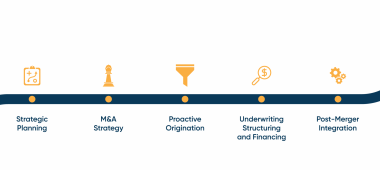The next Amazon is out there, and it’s coming for your company. Business disruption is a constant threat. There will always be another company looking to take market share from your business — or worse, replace you entirely.
The threat of business disruption is something you hear about constantly in the news. It’s common to read about Amazon acquiring a new startup or entering a new market, and how that is going to change the landscape of that industry. And clearly, investors believe the hype. When Amazon announced plans to acquire Whole Foods in June of 2017, it sent the stock prices of competing grocers tumbling. Kroger, Costco and Sprouts Farmers Market lost 9%, 7% and 6% respectively.
Even the mere suggestion that Amazon might disrupt a new industry sends shockwaves through the market. The same month Amazon announced its acquisition of Whole Foods, shoppers noticed the beta version of a “hire a realtor” service on Amazon’s homepage. Within hours, screenshots had circulated on trade websites, and the stock price of online real estate database company Zillow had dropped 3.5%. The very next day, Amazon removed the dummy page, and Zillow’s stock rebounded. But the message was clear: Everyone is afraid of Amazon and what it could do next.
The fear of business disruption is well founded. Amazon, once an online bookseller, has grown into a behemoth that dominates industries ranging from retail to cloud computing. And ultimately, Amazon is just one example. Business disruption is everywhere. The real threat comes from the rapid technological advancement we are currently experiencing. Whether it’s Amazon, Uber or some kid in a dorm room in Palo Alto, the next major industry disruptor is coming, ready to impact old-world industries previously believed to be bulletproof.
So, what’s the solution? Become the disruptor rather than the disrupted.
Embrace an agile business model
An agile business is one that can pivot in response to sudden market changes. Traditionally, businesses were static entities with well-defined structural hierarchies. There was a finance department, a sales department and so on. Each reported to its respective C-suite executive, who made decisions with other high-level executives and implemented changes within the department. This structure, while well defined and organized, is highly rigid and slow to adapt to changes. The built-in bureaucracy causes information to move slowly through the ranks.
In contrast, today’s top-performing businesses operate as networks of teams dedicated to specific projects. These teams are cross-functional, with all the key players necessary to oversee the assigned task. The constant communication facilitated by this model allows the company to quickly and efficiently adapt to ever-changing consumer preferences.
Place lots of small bets on business innovation
As with any investment, diversification is critical. Putting all your eggs in one basket comes with unnecessary risk and often ends poorly. Instead, find ways to strategically integrate new technology or business lines without completely upending your existing business model.
This is best done through acquisitions. Developing new technologies can take years and deplete your business of much-needed capital. A better strategy is finding an existing technology company, acquiring it and integrating it into your business. A perfect example is Walmart. With Amazon breathing down its neck and the rapid growth of e-commerce, Walmart acquired Jet.com to grow its online footprint.
Many technology companies are strapped for cash and looking for capital. By finding a tech startup that is lacking in sales and operating infrastructure but has a solid product that can improve your business, you can avoid a costly internal development process — and the high price tag many technology companies fetch in today’s market.















